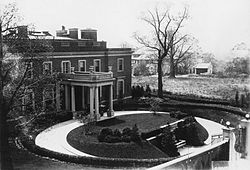White-Meyer House | |
 | |
| Location | 1624 Crescent Place, NW, Washington, District of Columbia |
|---|---|
| Coordinates | 38°55′13″N77°2′15″W / 38.92028°N 77.03750°W |
| Area | 1½ acres |
| Built | 1912 |
| Architect | John Russell Pope |
| NRHP reference No. | 87002293 [1] |
| Added to NRHP | January 20, 1988 |
The White-Meyer House is a historic mansion in Washington, D.C.'s Meridian Hill neighborhood of Northwest D.C. Designed by renowned American architect John Russell Pope, the residence was originally commissioned by diplomat Henry White.
Contents
- Timeline
- Architecture
- Architectural Details
- Landscape Features
- Preservation & Recognition
- See also
- References
- External links
The property's notable ownership history includes
- Rental to financier/ publisher Eugene Meyer, later purchaser in 1934.
- Acquisition by the Meridian International Center nonprofit in 1987.==History==

Renowned architect John Russell Pope designed the house and completed it in 1912. Henry White, an American diplomat and a retired ambassador to Italy and France, purchased the property in 1910. He hosted premier diplomatic salon during his stay, inviting well-known guests, including Georges Clemenceau, Robert Cecil, Henry Cabot Lodge and President Warren Harding. In 1917, Henry White lent the house to the French mission of Marshal Joseph Joffre to use as its headquarters. While the French flag flew outside of the residence, Marshal Joffre used the house to host high-level strategic meetings. Many policy meetings were had at the dining room table, including conversations that led to the establishment of the U.S Department of Health, Education and Welfare. When Henry White died, the house was passed on to his son John Campbell White. Financier Eugene Meyer rented the home while he was Chairman of the Federal Reserve (1930–1933), after which he bought the bankrupt Washington Post at auction. In 1934, Meyer bought the house from White for $355,000. During their ownership of the home, the Meyers hosted many prominent guests, including Eleanor Roosevelt, John F. Kennedy, Robert F. Kennedy, Adlai Stevenson, Thomas Mann, Earl Warren and Saul Alinsky. [2] [3]
After the Meyers' deaths, the house became the property of the Eugene and Agnes E. Meyer Foundation, which then leased the house to the Antioch Law School Library. In 1987, Meridian International Center purchased the property.
